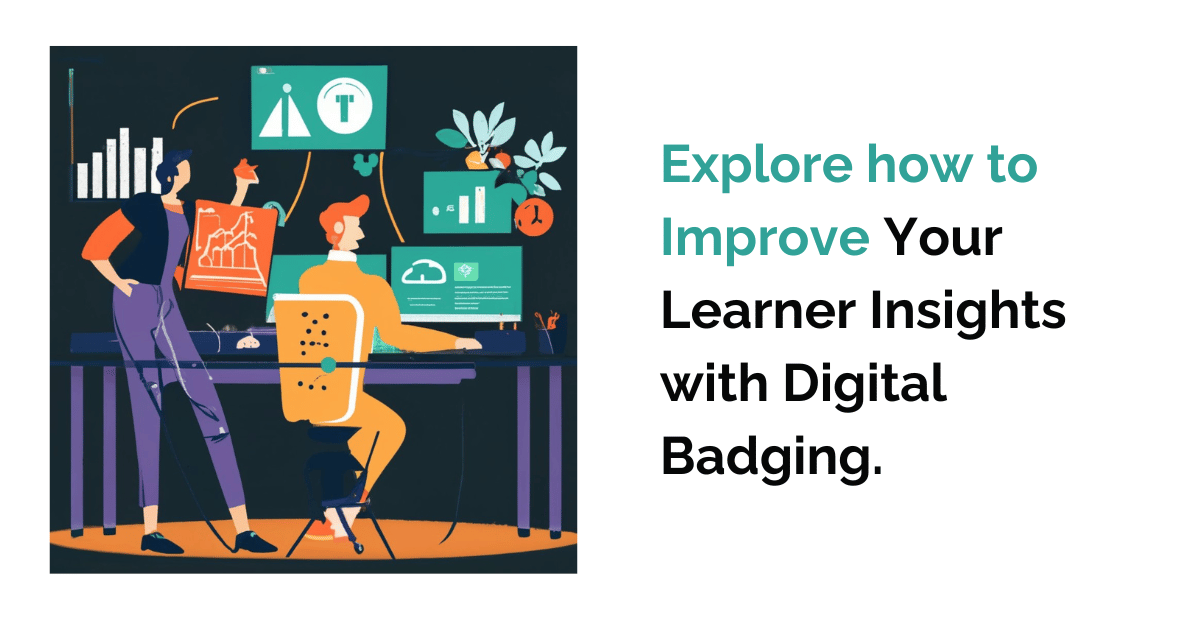Explore how to Improve Your Learner Insights with Digital Badging
Educational landscape, gaining valuable insights into a learner’s behavioural patterns, performance, and engagement is of paramount importance for organizations seeking to enhance the learning and education experience. These insights serve as a cornerstone for research purposes, helping institutions make data-driven decisions to improve their educational programs. However, the challenge lies in collecting this crucial student data while respecting learners’ data privacy rights. This is where the innovative concept of Digital Badging comes into play. Digital badges not only provide learners with a tangible representation of their achievements but also offer a unique avenue for institutions to collect invaluable insights into learner behaviour. In this comprehensive article, we will explore the world of Digital Badging, emphasizing its role in improving learner insights.
The Power of Verifiable Credentials
Verifiable credentials lie at the heart of digital badges. They ensure the authenticity and credibility of a badge, making it a reliable representation of a learner’s achievement. Verifiable credentials are cryptographically secured, ensuring that the information they contain cannot be tampered with or misrepresented. This level of security is essential in the world of digital education, where trust and accuracy are paramount.
Leveraging Digital Badges for Learner Insights

Motivating Learners Through Gamification
The effectiveness of digital badges in motivating and changing learner behaviour largely depends on the strategy used to deploy them. To maximize their impact, it is crucial to incorporate game design thinking into the badge system. Gamification, the integration of game elements and principles into non-game contexts, is a powerful approach for enhancing the learner experience. Gamification for learning is the art of applying game ideas and key components to achieve specific educational objectives. By infusing a gamification strategy into your educational program, you can create a more personalized and engaging learning experience for your students. This, in turn, provides valuable insights into their performance and behavioural patterns.
Key Gamification Elements
Incorporating gamification elements into your educational programs can yield significant benefits. Elements such as scoreboards, credit scores, and points serve as common gamification features that, when utilized effectively, can motivate learners to strive for the ultimate digital badge. Let’s delve deeper into how these elements contribute to learner insights.
-
Scoreboards
Scoreboards create a sense of competition and achievement among learners. When learners can see how they rank compared to their peers, it fosters a healthy competitive spirit that encourages them to excel. By monitoring the leaderboard, educators can gain insights into the most active and engaged participants in the learning process. -
Credit Scores
Assigning credit scores to various achievements and milestones helps learners track their progress and set clear goals. These scores serve as a visual representation of their journey, motivating them to earn higher scores and badges. Educators can analyze credit scores to identify areas where learners excel and areas that may require additional support. -
Points System
A points system allows learners to accumulate points for completing specific tasks or demonstrating mastery of a subject. These points can be redeemed for digital badges, creating a sense of accomplishment and progression. Analyzing point distribution provides educators with insights into which tasks or topics resonate most with learners.
Applying Gamification at Different Learning Levels

The adaptability of gamification makes it suitable for a wide range of learning levels and cognitive functions. It can be employed not only for initial learning but also for ongoing practice, skill improvement, upskilling, and real-world application of acquired knowledge. Digital badges, as a product of gamification, offer a valuable source of information about learner behavior, enabling institutions to assess the effectiveness of their training programs.
-
Analyzing Badge Data
Data collected through gamification tactics offers a wealth of information that can be harnessed to improve educational outcomes. By examining which badges are earned most frequently, institutions can gain insights into learner preferences and motivations. This data becomes especially useful when compared to other badges of the same type, helping educators understand which approaches and topics resonate most with learners. -
Identifying Potential Challenges
In instances where certain badges are rarely earned, educators can use this as an opportunity for introspection. It may indicate that the associated achievement or skill is too challenging or irrelevant to learners’ needs. In response, institutions can modify their learning methods, curriculum, or assessments to align with learner expectations and capabilities.
Digital Badges and Learner Data Privacy
One of the primary concerns in collecting learner insights through digital badges is maintaining strict adherence to data privacy regulations. Educational institutions and organizations must prioritize the protection of learner data while leveraging digital badges as a means of enhancing the educational experience.
Ensuring Data Privacy
To address data privacy concerns, organizations can implement the following measures:
-
Anonymization
Collect and store learner data in an anonymized format whenever possible. Remove personally identifiable information (PII) to ensure that data cannot be traced back to individual learners. -
Consent Mechanisms
Implement clear and transparent consent mechanisms that allow learners to choose whether to participate in badge-based data collection. Ensure that learners fully understand how their data will be used and for what purposes. -
Data Encryption
Utilize robust data encryption methods to protect any data that is collected and stored. Encryption ensures that even if data is compromised, it remains inaccessible to unauthorized parties. -
Compliance with Regulations
Stay informed about and comply with relevant data privacy regulations, such as the General Data Protection Regulation (GDPR) in Europe or the Family Educational Rights and Privacy Act (FERPA) in the United States. These regulations outline specific requirements for handling learner data.
Digital Badging Best Practices
To harness the full potential of digital badges for improving learner insights, institutions should follow these best practices:

-
Clearly Defined Badge Criteria
Ensure that badge criteria are well-defined and aligned with learning objectives. Learners should have a clear understanding of what is required to earn a badge. -
Diverse Badge Types
Offer a variety of badge types to cater to different learning styles and preferences. This encourages broader participation and engagement. -
Integration with Learning Platforms
Integrate digital badges seamlessly into existing learning management systems and platforms. This simplifies the badge-earning process for learners. -
Regular Evaluation
Continuously assess the effectiveness of your badge system by analyzing learner data and feedback. Make necessary adjustments to improve the program’s impact. -
Recognition and Reward
Celebrate and acknowledge learners who earn badges by showcasing their achievements. Recognition can further motivate learners to engage with the educational content.
Real-World Applications of Digital Badging
Digital badges have found applications in a wide range of fields beyond traditional education. Let’s explore some real-world scenarios where digital badges are making a significant impact:
-
Workforce Development
In the realm of workforce development, digital badges are used to validate and recognize skills acquired through online courses, workshops, and on-the-job training. Job seekers can showcase their badges to potential employers, providing tangible evidence of their capabilities. -
Professional Certifications
Professional organizations and industry bodies issue digital badges to individuals who have achieved specific certifications and qualifications. These badges serve as a portable and verifiable record of expertise, enhancing professionals’ credibility. -
Continuing Education
Digital badges are instrumental in promoting lifelong learning. They motivate individuals to pursue continuous education and upskilling by offering a clear path to track their progress and achievements. -
Nonprofit and Volunteer Work
Nonprofit organizations and volunteer groups use digital badges to recognize and celebrate the contributions of volunteers. These badges can serve as a testament to an individual’s commitment to a cause.
Future Trends in Digital Badging
The field of digital badging continues to evolve, driven by technological advancements and changing educational paradigms. Here are some emerging trends to watch out for:
-
Blockchain Integration
The integration of blockchain technology in digital badges is on the rise. Blockchain provides an immutable and transparent ledger for storing badge data, enhancing the security and trustworthiness of digital credentials. -
AI-Powered Badge Recommendation
Artificial intelligence is being employed to recommend badges and learning paths based on an individual’s learning history and goals. This personalized approach enhances learner engagement. -
Micro-Credentials
Micro-credentials, smaller units of learning recognition, are gaining popularity. Learners can earn numerous micro-credentials, which collectively contribute to a broader skillset or qualification. -
Cross-Institutional Badges
Collaborative efforts among educational institutions are resulting in cross-institutional badges. Learners can accumulate badges from various sources, creating a more comprehensive and diverse credential portfolio.
Conclusion
As the digital badging landscape continues to evolve, educational institutions and organizations have the opportunity to harness its full potential. By following best practices, staying attuned to emerging trends, and fostering a culture of lifelong learning, institutions can unlock the door to improved learner insights and a brighter educational future. Digital badges are not just symbols of achievement; they are beacons guiding learners on their educational journey, inspiring them to reach new heights of knowledge and competence.

 Author :
Author : 







